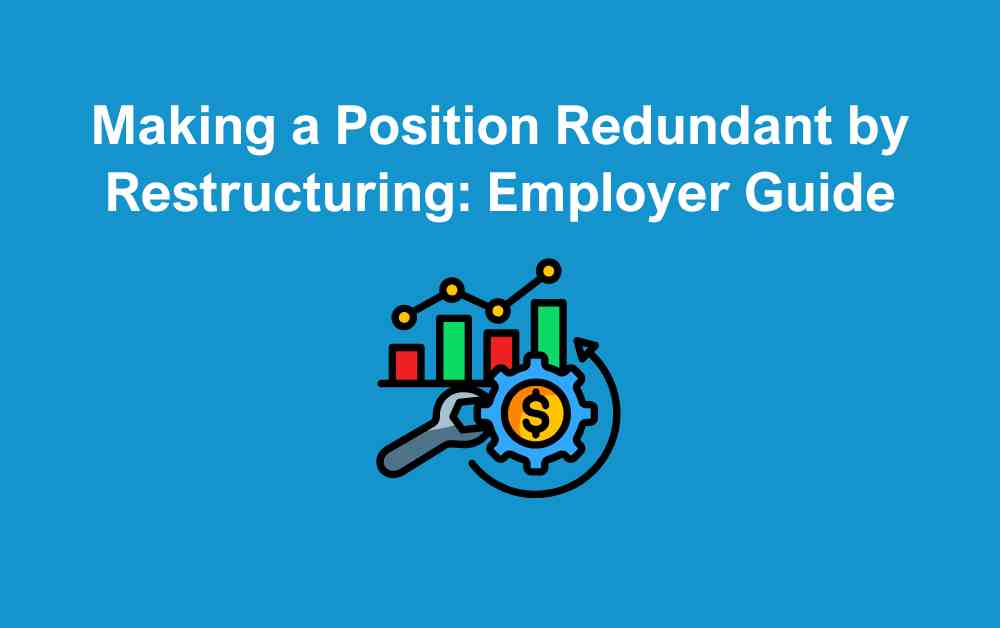Planning and Managing a Fair Redundancy Restructure
Before deciding which positions may need to be made redundant, it is vital to carefully plan your restructuring process. A fair, transparent, and legally compliant approach is crucial to avoid potential disputes and maintain trust within the organisation.
If your reorganisation results in staff dismissals, you must prioritise the rights of your employees throughout the process. Employees with two or more years of service are legally protected against unfair dismissal and are entitled to statutory redundancy pay. Failing to uphold these rights can lead to legal challenges and damage to your business’s reputation.
To ensure a making a position redundant by restructuring is fair and compliant, follow these key steps:
1. Create a Clear Business Case
Provide a strong and well-documented rationale for the need to dismiss staff. This should outline the economic, structural, or strategic reasons for the restructuring, ensuring the decision is both necessary and proportionate.
2. Explore Alternative Roles
Before confirming redundancies, actively seek alternative roles within the business for affected employees. Redeployment options can reduce the number of dismissals and demonstrate a commitment to supporting your staff.
3. Hold Meaningful Consultations
Consultation is a critical part of the redundancy process. For 20 or more employees facing redundancy, UK law requires collective consultation, involving two or more meetings and detailed discussions. While not mandatory for fewer redundancies, holding at least one consultation is considered best practice and fosters transparency.
4. Use a Fair Selection Process
When selecting employees for redundancy, apply objective and measurable criteria, such as skills, performance, or attendance records. Avoid discriminatory factors when making a position redundant by restructuring. Ensure the process is impartial and evidence-based.
5. Provide Written Redundancy Notices
Formal notice must be given to employees selected for redundancy. This should clearly explain the reasons for the decision, their rights, and any relevant timelines for leaving the business.
6. Ensure Correct Redundancy Pay
Employees with two or more years of service are entitled to statutory redundancy pay. Ensure calculations are accurate and comply with legal requirements. In some cases, enhanced redundancy packages may be offered as part of company policy.
7. Offer the Right to Appeal
Employees have the right to appeal your decision if they feel the process was unfair or the reasoning was flawed. Be prepared to handle appeals professionally and transparently, providing clear records to justify your decisions.
8. Maintain Comprehensive Records
Document every stage of the process, including consultations, selection criteria, and communications with employees when looking at making a position redundant by restructuring. These records can be invaluable if you need to prove that your actions were fair and objective.
Why a Fair Redundancy Process Matters
A fair and legally compliant redundancy process protects your business from potential claims of unfair dismissal and ensures that employees feel respected, even in challenging circumstances. By following these steps, you can navigate restructuring with integrity, minimise disruption, and safeguard your organisation’s reputation.
How to Manage TUPE Redundancy and Restructuring
TUPE applies when a UK business (or part of it) transfers to a new employer or when services are outsourced to a contractor. Its purpose is to protect employees’ continuity, terms, and conditions during such transfers. However, redundancies may arise if the new employer needs to restructure or cut costs. If this is the case, employers must handle redundancies carefully, following the appropriate legal procedures, especially when considering collective redundancies for 20 or more employees. In such situations, collective consultation is required, and pre-transfer consultation may be possible with the agreement of the transferring employer (transferor).
Pre-transfer consultations can be complex, as the transferee must demonstrate that a relevant transfer is taking place, that redundancies will affect 20 or more employees within 90 days, and that those redundancies relate to employees being transferred. Without cooperation from the transferor, consultation can be challenging, particularly in giving employee representatives access to transferring staff. When collaboration is not feasible, postponing redundancies until after the transfer may be advisable to ensure compliance with TUPE and redundancy laws. Seeking expert guidance is essential to navigate this process effectively.
Benefits of a Well-Handled Restructuring Process
When making a position redundant by restructuring is managed correctly, it can lead to:
- Improved Efficiency: Restructuring can streamline processes and reduce duplication of effort.
- Employee Trust: Transparent communication fosters trust, even in difficult times.
- Business Growth: A well-aligned team contributes to achieving strategic goals.
Common Pitfalls to Avoid
- Lack of Transparency: Keeping employees in the dark breeds mistrust and anxiety.
- Non-Compliance: Failure to adhere to legal requirements can lead to disputes or claims.
- Ineffective Communication: Miscommunication can result in confusion and resentment among staff.
Final Thoughts
Making a position redundant by restructuring is a challenging process, but it can be handled effectively with careful planning and empathy. By prioritising transparency, following legal guidelines, and offering support to affected employees, businesses can navigate this transition smoothly and ethically.
If you need guidance on restructuring and managing redundancy, get in touch with our HR experts. They can ensure compliance and help you implement changes with minimal disruption.







